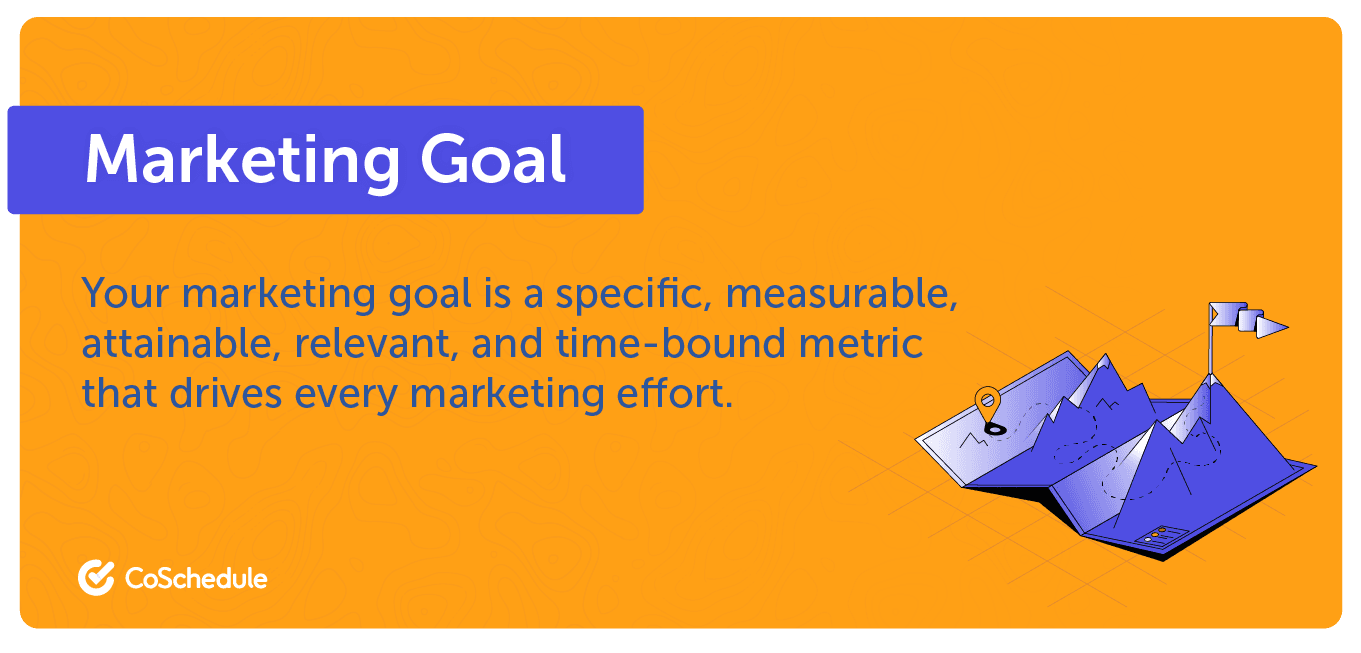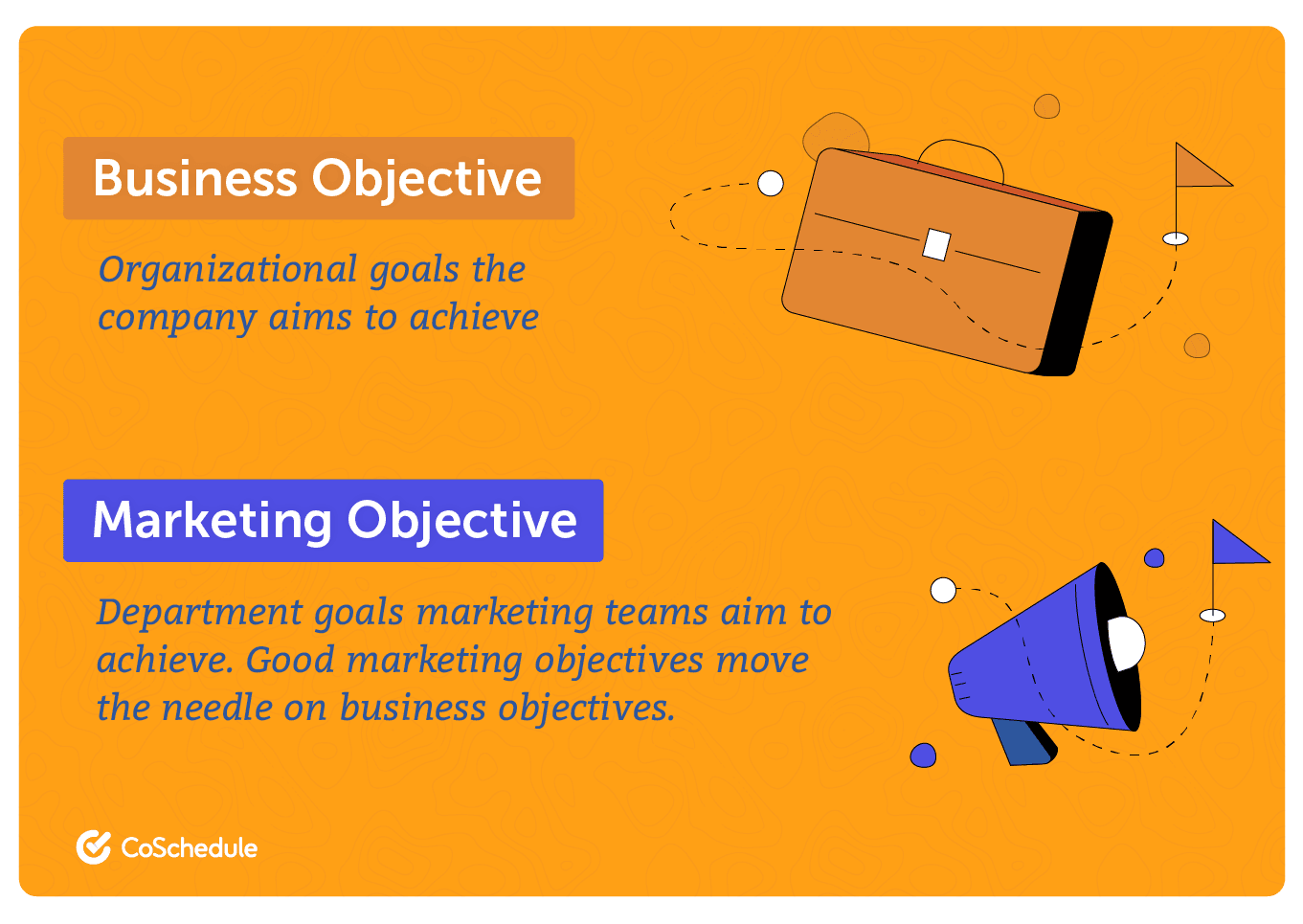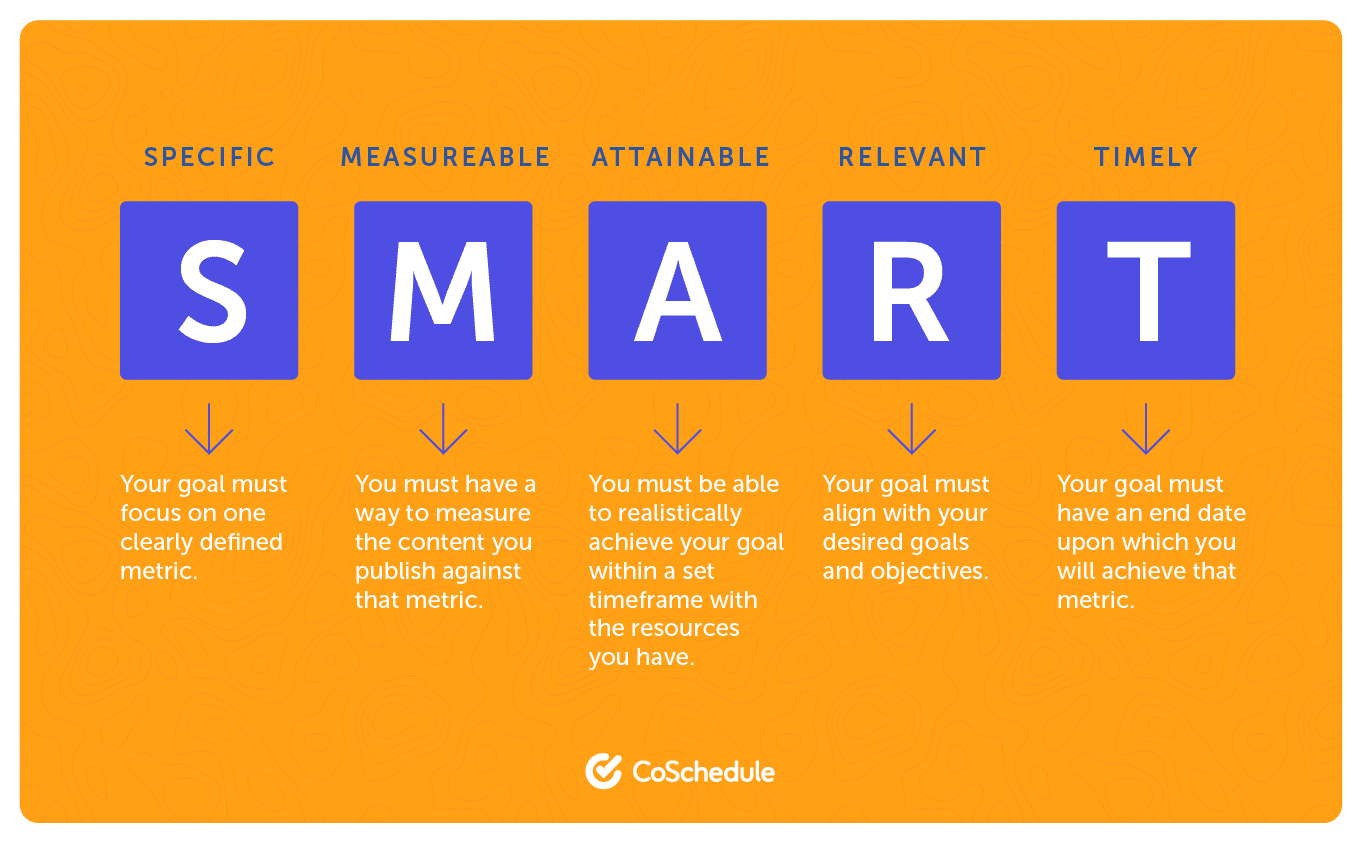Marketing is all about goals. Without them, you have no way of knowing whether or not your work is worthwhile. Think of it like planning a trip. In order to know when you’ve arrived, you need to select a destination first. Otherwise, you would be traveling aimlessly.
There’s another word for that: getting lost. If your boss asked about where your company’s marketing was headed, you wouldn’t want to say, “We don’t know,” right? Of course not. You’d want to show you have a clear plan, one that’s held accountable to hard numbers. Fortunately, setting goals doesn’t have to be difficult.
What Are Marketing Goals?

Why Is Goal-Setting Important?
Marketers who write down their goals and objectives are more likely to make them a reality. The data is hard to ignore. According to original CoSchedule research:
“Marketers who set goals are 376% more likely to report success than those who don’t. And 70% of those successful, goal-setting marketers achieve them.”
That appears to be firm confirmation in favor of setting goals. But, this leaves an open question: why does setting goals lead to greater success? According to Mareo McCracken, goals provide clarity Without them, we drift aimlessly from task to task, without a clear understanding of how our work makes a difference. With clear goals in place, you can begin constructing the strategy to achieve them.

Examples Of Common Business Goals
What are some common business objectives marketing teams may want to accomplish? Here is a list:
- Drive more sales
- Grow brand awareness
- Expand market share
- Develop stronger relationships with stakeholders
- Enter new markets or territories
- Reach new audiences or demographics
- Raise more revenue
- Secure funding
- Increase profits
Examples Of Common Marketing Goals
Those are some examples of broad business objectives. Now, what are some more specific goals that might be relevant?
- Increase website traffic
- Gain more social media followers
- Grow an email list
- Improve conversion rates
- Get more website or social media engagement
- Drive more click-throughs on paid ads

Make Your Marketing Goals SMART
SMART stands for specific, measurable, attainable, relevant, and timely:
- Specific: Your goal must focus on one clearly defined metric.
- Measurable: You must have a way to measure the content you publish against that metric.
- Attainable: You must be able to realistically achieve your goal within a set timeframe with the resources that are (or will be) available to you.
- Relevant: Your goal must align with your desired goals and objectives.
- Timely: Your goal must have an end date upon which you will achieve that metric.

Understand The Goals Of Your Business
As a marketer, you are not judged based only on activities or productivity. Your value is connected to your results. In order for your marketing to be meaningful, it needs to move the needle on key business objectives. Remember the common business goals listed earlier? That’s what this means. To do this, make sure your marketing goals are tied into a business objective.
For example, you may want to gain more social media followers. This is great! But, how does this help the business? Here are a few benefits:
- Increased brand awareness
- Establish your business as an authority
- Reach new customers
These are all objectives that help make a meaningful impact on your business. So, when setting goals, select ones that will drive business results, and not just produce impressive-sounding numbers that aren’t actually relevant.
How To Connect Marketing Goals To Business Goals
Your business may have broad goals that are not set by your marketing team. Make sure you understand what these are. If these are not clear to you, this may mean talking to your CMO, CEO, or other executives who know the company’s goals.
Most organizations make goals clear to their employees, but if this is not the case in your organization, you may have some extra legwork to do. The point is to be certain you understand what your company is trying to achieve, so you know you’re investing your marketing resources in the right places.
Let’s say your company needs to get more customers. In order to achieve this, you need to generate ten leads per week. The sales team needs help from marketing to drive these leads. The business objective is to increase revenue by increasing customers. A good marketing objective could be any that help generate more leads.
Key Marketing Goals For Success
When it comes to success in marketing, it is essential to increase brand awareness to better build recognition among your target audience.
A key marketing goal is to attract potential customers and get their contact information, then build trust and loyalty in order to turn those leads into customers.
Some strategies that you can use to improve attracting leads are:
- Create lead magnets to grow your subscriber list
- Optimize landing pages to drive more traffic
- Run targeted advertising campaigns
You can prioritize driving website traffic through SEO tips and best practices. Easily maintain your customer retention by improving your customer loyalty while also reducing churn rates through loyalty programs, personalized marketing, and excellent customer service. In return, this will also expand your reach by building a strong social media presence and creating engaging content, and achieving audience interaction to establish a brand community.
How To Set Marketing Goals
So follow this framework to write yours:
By {insert day, month, year}, the {insert your organization’s name} marketing team will reach {insert number} {insert metric} every {insert time frame}.
Here’s a marketing goal example written using that framework to give you more context:
By December 31, 2018, the CoSchedule marketing team will reach 6,000 marketing-qualified leads every month.
In that example, the goal is to influence marketing-qualified leads. Remember, the point of your marketing strategy is to choose, prioritize, plan, and execute projects to influence profitable customer action. Therefore, marketing metrics closer to the ultimate purchase are often the best goals to set. However, all goal setting influences the right kinds of behavior. And when you’re just beginning, you may opt to focus on other metrics.
Here are several other marketing goals examples listed from awareness to closest to the purchase:
- Page views
- Email subscribers
- Trial signups
- Purchases
Mapping Goals To Your Funnel
This path makes sense for a subscription-based software company. To figure out which goals and metrics matter most for you, start by understanding the marketing funnel.

This basic illustration outlines three areas most funnel models include:
- Discovery (Top of the Funnel): People learn about your brand when looking for a product.
- Consideration (Middle of the Funnel): The consumer moves past browsing, and is now actively considering which product to purchase.
- Purchase (Bottom of the Funnel): A company closes the deal. Hopefully, that means your company.
Your next step is to determine metrics and goals for each step. At the top, you might focus on things that bring in awareness. That could include:
- Getting website traffic
- Growing a social media following
- Placing news articles
- Driving advertising impressions
- Email subscriber growth
Next, identify metrics that track with where customers are at in the middle of the funnel. Those metrics could include:
- Increasing email open rates
- Generating more leads
- Improving lead quality
- Getting more ad clicks
Finally, look at metrics closer to the point of purchase. This may include:
- Trial or demo signups
- Calls for more information
- Scheduling a consultation
- Purchases
Choose your marketing metric for the one most important goal you’ll set.
Plan & Achieve Your Marketing Goals With Time-Bound Deadlines
If you haven’t already, download the marketing strategy template kit. The first tab of the marketing strategy template spreadsheet is labeled Goal Tracking. ![]()
Look at the Assumptions area in columns A–C, and fill in the goal numbers and time frame in which you’d like to complete the goal. Enter your Start Goal number in cell C6. This is the amount you influenced toward your goal either the prior month, or you may opt to average several prior months of data.
For our marketing goal example, the Start Goal is 600, which is the average number of marketing-qualified leads generated in the months of October, November, and December. Enter your Final Goal number in cell C7. This is the number you want to influence by the end of your time-bound deadline.
Back to the marketing goal example, the Final Goal is 6,000. That’s to say, you want 6,000 marketing-qualified leads by December 31, 2018, which is the end of the time-bound deadline you defined in your SMART marketing goal statement. If you’d like to define a Stretch Goal, enter it in cell C8. This is basically 10x-ing your 10x goal.
In the example, the Stretch Goal is 7,000. That means you want 7,000 marketing-qualified leads by the end of 2018. The Months To Complete Goal indicates how many months you’ll need to complete the goal. The example spreadsheet is set up for 12 months, suggesting you’ll start working toward completing the goal in January and reach the goal in December.
At this point, you’ll notice the Final Goal and Stretch Goal numbers in the December column Q match what you entered in the Final Goal and Stretch Goal cells in the Assumptions area. The months leading to December amortize toward that goal, suggesting continuous growth every month leading toward the end of the time-bound structure of your goal setting process.
The marketing goal amortization formula looks like this:
(Final Goal – Start Goal) × (month number / months to complete goal)^ 2 assumption + start goal = goal conversion goal for a specific month
How To 10X Your Goals
The 10x growth framework suggests focusing on the aspirational part of the goal as much as possible. Therefore, you may opt to calculate your goal with this formula: Average Current Monthly Contribution To Metric × 10 = Marketing Goal.
For example, that would like this in practice: 600 marketing-qualified leads in an average month × 10 = 6,000 marketing-qualified leads per month goal. For some marketers, however, increasing your goal 10 times over may be unrealistic. If you fall into this category, change the 10 to a number that makes your aspirational goal realistic. The point here is to define an end number that is aspirational but within your practical means of achievement.
As you communicate this number to your team, you will influence the right behavior, and the right behavior often produces the right results.
You Did It!
Congrats! You just set marketing goals for every month for an entire year.
